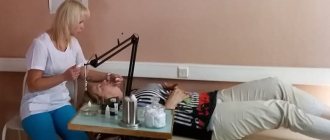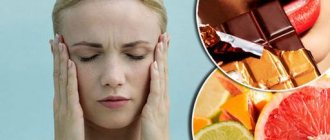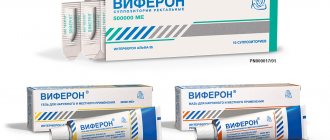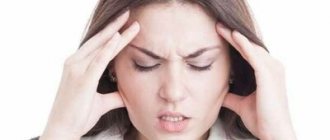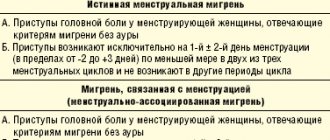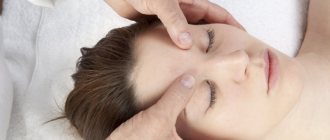Why does cervical migraine occur?
Cervical migraine syndrome occurs due to several factors. Conventionally, they can be divided into two categories:
- Those related to problems in the vertebrae.
- Those that do not relate to vertebral lesions.
Nonvertebrates:
- Pathologies of the structure of the spinal artery, which are present from birth.
- Affected vessels.
- Anomalies in the location of blood vessels.
- Myositis.
Causes related to the vertebra:
- Pathologies of the vertebral structure.
- Vertebral deviations due to injury.
- Osteochondrosis of the vertebrae.
- Unstable functioning of the cervical vertebrae.
- Problems whose consequences are difficult to determine.
Forms of migraine
There are two main forms of the disease. If a headache begins suddenly without previous symptoms, it is considered a migraine without aura. The appearance of visual, olfactory or other disturbances within 60 minutes before a headache attack is called an aura. Moreover, each person suffering from this disease can experience both forms alternately.
The disease can be episodic, with attacks occurring rarely. But if left untreated, the disease becomes chronic. This form includes options in which headaches occur more than 15 days a month for any 3 months over the last six months. Sometimes headache attacks with chronic migraine do not meet all the criteria for pathology and are more reminiscent of tension headaches.
There are different types of migraine:
- retinal migraine – pain is accompanied by blurred vision, sometimes even temporary blindness occurs in one eye;
- periodic syndromes of childhood are headaches in children that, by most criteria, resemble migraines; they usually then develop into a full-fledged disease;
- abdominal migraine – pain in the abdomen occurs before or simultaneously with a headache attack. Children may experience vomiting or nausea beforehand.
- basilar migraine
- hemiplegic migraine
- aura without migraine
Symptoms of cervical migraine
The main sign that you have a cervical migraine is unbearable pain in the head area. But also when:
- The pain lasts all the time or occurs intermittently.
- The pain becomes unbearable, brings agony and constantly pulsates.
- During attacks, the eyes, bridge of the nose, or ears and forehead begin to hurt.
- A feeling of pain also appears with any touch.
- When you turn your head, you feel terrible discomfort.
- There is a ringing in the ears that pulsates along with the heartbeat.
- Dizziness, vomiting and nausea are common.
- There are problems with hearing and vision.
- A lump appears in the throat and swallowing is impaired.
- The body becomes hot, or vice versa, it makes you shiver.
These are the main problems that occur with cervical migraine.
Migraine
Migraine is a widespread pain syndrome.
Cervicocranialgia (syn. Cervical migraine) is a disease characterized by headaches due to disorders in the spine.
According to statistics, 15-20% of the population suffers from headaches; women are five times more likely to suffer from headaches. In most cases, it occurs in people aged 35-40 years; 70% of patients have a hereditary predisposition.
The pain, as a rule, is pulsating in nature, in the occipital region or back of the neck, a feeling of “fog”, “midges” in the eyes, dizziness, tinnitus.
Our health directly depends on the condition of the spine, and if pain occurs, it means that the body can no longer compensate for the problems that exist. In the case of migraine, a headache may be a sign of cervical osteochondrosis or intervertebral hernia, and this means that you should not delay treatment and immediately consult a specialist.
Displacement of the cervical vertebrae leads to obstructed venous outflow, as a result of which cerebral circulation is disrupted and oxygen starvation occurs, resulting in a migraine attack.
Anatomically, the cervical spine is one of the most responsible in our body. Disturbances in this department cause not only headaches, but also frequent allergies, hypertension, visual impairment and others.
The consequence of not treating migraines is status migraine - these are attacks of unbearable headaches that occur one after another and without adequate treatment can lead to a brain stroke.
Causes of migraine:
- emotional stress
- nervous and physical stress
- meteorological factors (pressure and temperature changes)
- irregular food intake, foods rich in tyramine (cocoa, chocolate, nuts, citrus fruits and others)
- alcohol, especially red wine
- incorrect head position during sleep
Success in treatment can only be achieved with timely consultation with a doctor. The sooner treatment is started, the faster you will forget about your problem.
And remember that a headache is only a symptom, and in order to get rid of the problem, it must be treated.
Migraine treatment at OSTEOMED
Using analgesics, patients eliminate not the cause of the disease, but the consequence, without the proper therapeutic effect. The causes of migraine are not limited to the cranial cavity and can be hidden in any corner of the human body. The main osteopathic approach is a complex effect on the body, taking into account the factors causing the disease. The use of osteopathic techniques can improve venous and liquor outflow from the cranial cavity, balance the autonomic nervous system, and reduce tension in the dura mater of the brain and spinal cord. This is only a small part of what an osteopathic doctor can do, because, as you know, it is not the disease that needs to be treated, but the patient, which is what we successfully do.
Despite the fact that in the treatment of migraine in women and men, a huge role is currently played by the selection of medications, the identification of the causes of symptoms, the doctor’s ability to build a dialogue with the patient, and correctly formulate his expectations are crucial for the success of therapy.
Answering the question of how to get rid of migraines, doctors at the Osteomed clinic practice an individual approach to treatment, including recommendations for lifestyle changes. Only a serious integrated approach will achieve maximum effect.
Treatment
After diagnostics and other additional examinations, neurologists offer the following methods of therapy:
- Use of anti-inflammatory and pain relievers.
- Prescribing medications that can improve blood circulation.
- Consumption of vitamin B complexes.
- Drugs to protect nerve cells from hypoxia.
- Sometimes cervical massages and special physical exercises are used.
- Severe cases require surgery.
Posterior cervical sympathetic Barre syndrome can be cured if you promptly consult a competent specialist and complete a full course of treatment. If the situation is advanced, then you can simply relieve the pain. Prevention of this disease is considered to be strengthening the back muscles, correct posture, avoiding spinal injuries and proper nutrition.
Clinical Brain Institute Rating: 5/5 — 8 votes
Share article on social networks
How to help someone with migraine
Since this type of cephalgia is not a symptom of the disease, it is necessary to eliminate the provoking triggers. To do this you need:
- normalize nutrition;
- avoid skipping meals;
- get enough sleep;
- reduce mental stress;
- engage in moderate physical activity;
- relieve stress.
If you don't know exactly what causes a headache, it can be helpful to keep a diary and write down what preceded the next attack. But it is not recommended to carry out drug therapy on your own. Headache attacks may conceal more serious pathologies that require special treatment. It can be:
- malignant neoplasms of the nervous system;
- transient ischemic attack;
- ischemic cerebral stroke;
- subarachnoid hemorrhage;
- dissection of the carotid or vertebral artery;
- cerebral vasculitis.
For the treatment of migraine, medications are selected depending on the intensity of the attack. For mild forms, non-steroidal painkillers can be used. Evidence of effectiveness is available for the following medicines:
- Aspirin tablets;
- Paracetamol in tablets or suppositories;
- Ibuprofen tablets;
- Diclofenac tablets or injections.
Sometimes, for greater effectiveness, a combination of different types of non-steroidal anti-inflammatory drugs is prescribed: Brustan, Trigan, Panoxen. It is effective to add caffeine to the therapy regimen, as in the tablets Solpadeine Fast, Askofen, Citramon.
If painkillers are ineffective, triptans are included in the treatment regimen. This is a class of substances that are effective in 75% of patients with headaches. They are marketed under the names Sumatriptan and Sumamigren. These drugs have few side effects, but can cause myocardial ischemia in patients with diseases of the cardiovascular system. For those for whom triptans are not contraindicated, the effect can be enhanced with naproxen.
For those for whom triptans are contraindicated, metoclopramide is prescribed. It helps relieve headache attacks and is often used as an emergency remedy. Also in development are new generation drugs that are agonists of serotonin receptors or belong to the group of monoclonal antibodies that block an excess of a certain neurotransmitter.
In children, the only approved drugs are ibuprofen or paracetamol. In adolescence, it is allowed to use their combination Ibuklin Junior.
Seizure prevention
To reduce the number of attacks, experts recommend:
- avoid mental fatigue;
- avoid stress factors;
- avoid head injuries;
- take regular walks in the fresh air;
- moderate physical activity;
- healthy lifestyle.
Lack of qualified help for migraines can lead to complications. Among them are neuroses, depression, psychosomatic diseases, as well as background headaches that are difficult to treat.
It is important to start treatment at the initial stage to prevent attacks from becoming chronic, a pronounced decrease in quality of life and loss of ability to work.
Non-drug methods of prevention
A migraine attack can be prevented not only with the help of medications. Cognitive behavioral therapy can reduce stress levels and correct pain syndrome. Through sessions with a doctor, patients are able to learn psychological and muscle relaxation techniques. Cognitive-behavioral therapy is indicated for persons with signs of emotional-personal and hypochondriacal disorders. In severe cases, observation by a psychiatrist is necessary.
Neck massage, acupuncture, therapeutic exercises and manual therapy have a positive effect. In the absence of effect from drugs, the use of various instrumental methods is indicated. Among them are stimulation of the occipital, vagus and supraorbital nerves.
Symptoms
Migraine symptoms can appear before the headache, just before the headache, during the headache, and after the headache. While not all types of migraines are the same, typical symptoms include:
- Moderate to severe pain, usually localized to one side of the head
- Throbbing headache
- Increased pain intensity during physical activity
- Inability to perform normal activities due to pain
- Nausea
- Vomit
- Increased sensitivity to light and sound.
Migraine with aura - Many people experience migraine attacks with an aura, which occurs just before or during a headache, but not everyone gets an aura.
The aura is manifested by disturbances of perception such as:
- Unpleasant thoughts or experiences
- Perception of strange lights sparkling or flashing
- Stripes in the field of view
- Blind Spots
- A tingling sensation of needles in the arms or legs
- Stiffness in the shoulders, neck, or limbs
- Feeling of unpleasant odors.
When migraine with aura affects vision, the patient may see things that are not there, such as transparent structures of objects, not see part of an object in front of them, or even feel as if part of their visual fields appears, disappears, and then comes back again.
When patients describe visual disturbances, the most common description is a description of visual disturbances similar to the sensations that arise after being photographed with a camera with a very bright flash, which was taken in a dark room.
For many migraine sufferers, the aura acts as a warning, signaling that a headache is coming.
In adults, the aura usually develops before the headache, but in children the aura can develop before and during the headache at the same time.
Migraine sufferers may also have a premonition called a prodrome, which can occur within a few hours or as long as a day before the headache occurs. These premonitions may consist of feelings of euphoria, increased energy, sugar cravings, thirst, drowsiness, irritability, or depression.
Diagnostics
The diagnosis of migraine is based primarily on medical history and the presence of characteristic symptoms. The International Headache Society recommends "5, 4, 3, 2, 1 criteria" for diagnosing migraine without aura. These criteria are:
- 5 or more headaches
- duration of attack from 4 hours to 3 days
- The presence of at least 2 attacks with unilateral localization, pulsating nature, moderate to severe pain, aggravated by exercise and prevented by the absence of usual physical activity
- At least 1 additional symptom such as nausea, vomiting, sensitivity to light, sensitivity to sound.
Instrumental examination methods such as electroencephalography (EEG), computed tomography (CT), magnetic resonance imaging (MRI) and spinal tap are used to exclude conditions such as:
- Brain hemorrhage
- Subdural hematoma
- Stroke
- Dilated blood vessels in the brain
- Increase or decrease in cerebrospinal fluid
- Inflammation of the membranes of the brain and spinal cord
- Inflammation of the sinuses
- Postictal headache (after a stroke or seizure)
- Brain tumors
Migraine prevention
To reduce the likelihood of headache recurrence, lifestyle changes are necessary. If a connection is made with certain trigger factors, it is recommended to avoid them in everyday life. Patients who experience attacks more than 2 times a week are prescribed drug prophylaxis. Topiromat tablets can be used for this; Metoprolol. Magnesium supplements improve the condition of the nervous system.
Physical therapy can help prevent migraines. To do this, work with a psychotherapist is prescribed, and methods of cognitive and behavioral therapy are used. Additionally, massage, acupuncture, physiotherapy and other methods of prevention are used.
Budik Alexander Mikhailovich, neurologist, CMN, chief physician of medical offices 36.6
THERE ARE CONTRAINDICATIONS, BEFORE USE YOU MUST CONSULT WITH A SPECIALIST
Causes
Some people who suffer from migraines can clearly identify the triggers or factors that cause their headaches, but many patients cannot. Potential migraine triggers include:
- Allergies and allergic reactions
- Bright lights, loud noise, certain odors or perfumes
- Physical or emotional stress
- Changes in sleep patterns or irregular sleep
- Smoking or exposure to smoke
- Skipping meals or fasting
- Alcohol
- Menstrual cycle fluctuations, birth control pills, hormone fluctuations during the onset of menopause
- Foods containing tyramine (red wine, aged cheese, smoked fish, chicken liver, figs, and some beans), MSG, or foods with nitrates (such as bacon, sausages, and salami)
- Other foods such as chocolate, nuts, peanut butter, avocados, bananas, citrus fruits, onions, dairy products and fermented or pickled foods.
Triggers do not always cause migraines, and avoiding triggers does not always prevent migraine attacks.
Migraine treatment
The main goal of treatment for migraine attacks is to alleviate the course of the disease, improve the quality of life and reduce the risk of chronicity of the disease. Treatment includes:
- relief of acute pain syndrome;
- relapse prevention.
Treatment of acute migraine attacks
The following drugs are used to relieve pain:
- Nonsteroidal anti-inflammatory drugs (ibuprofen, ketorolac, diclofenac, acetylsalicylic acid, paracetamol). It is important to remember about the possibility of developing an overuse headache. It occurs due to excessive use of painkillers.
- Antiemetics. Prescribed due to the presence of severe atony of the stomach and intestines, which accompanies migraine. Antiemetic drugs stimulate intestinal motility and normalize absorption.
- Triptans. They are the “gold standard” of migraine therapy. The drugs block the release of pain neuropeptides. The effect occurs 20-30 minutes after ingestion.
It is recommended to start therapeutic measures as early as possible. It is advisable to take the drug within the first 30 minutes after the onset of the attack. Therapy is selected individually by the attending physician.
Causes of occipital neuralgia
The main cause of the disease is compression or irritation of the occipital nerve roots.
It may arise as a result of:
- long-term stress on the neck muscles. This problem is often encountered by people who spend a long time in one position (for example, at the computer or sewing machine);
- diseases of infectious and inflammatory origin;
- head or spine injuries;
- neoplasms;
- metabolic disorders (diabetes mellitus, gout);
- inflammatory processes in blood vessels (vasculitis);
- osteoarthritis of the joints of the cervical vertebrae and compression of the nerve roots due to degenerative changes;
- various systemic pathologies.
If the cause of the disease cannot be determined during the examination, we are talking about primary or idiopathic neuralgia.
Causes of migraine
The exact causes of migraine symptoms have not yet been studied. The main role is played by hereditary burden. There are provoking factors, the presence of which contributes to the appearance of migraine headaches. These include:
- emotional stress;
- menses;
- hunger;
- insomnia;
- weather change;
- excessive sleep;
- food products (chocolate, citrus fruits, bananas, fatty cheeses);
- alcohol.
Quick help
At the initial stage of the next attack, you can drink sweet tea. Raising your blood sugar may stop your headache from getting worse. It is recommended to perform acupressure on the back of the head and neck, pressing on the occipital protuberance and carotid arteries with the fingertips. Such actions can delay the pain until the pill takes effect.
Herbal teas, sedatives, hot showers, and warming the feet have a positive effect on overall well-being.
